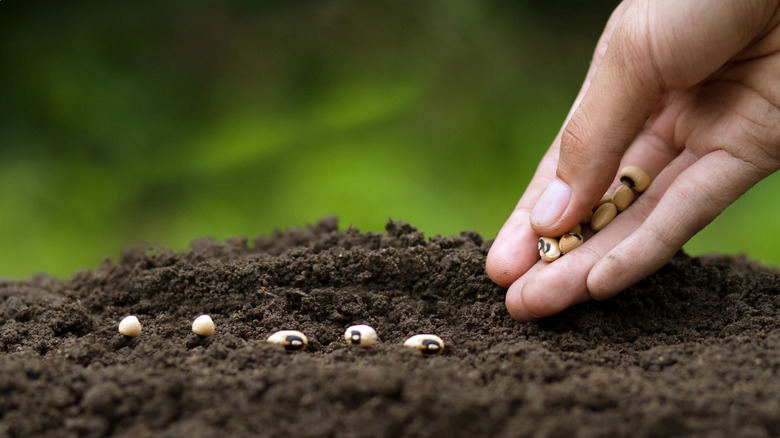Don't Buy Any Seeds For Your Garden Until Taking One Necessary Step
We all have some sort of item that we're prone to impulse buying. For some, it might be books, while for others it's clothes. But for the gardeners among us, an impulse purchase might actually look like being drawn in by the pretty packaging at Ace Hardware, and buying way too many packets of carrot seeds with visions of starting a veggie garden before realizing the flower box outside your window probably isn't deep enough for any decent-sized carrots to grow at all. Gardening might seem like an art, but really it's somewhat of a science — so please, sit down with a pencil and paper, and take some time to plan out the arrangement of your garden before you buy any seeds for it.
For any given plant, you can look online or in gardening books to see how much space it will need horizontally and vertically, both of which are factors that are going to be important to your planning. Don't try and squeeze things in: To thrive, plants need sufficient space for their roots to spread through the soil gathering nutrients, and if you overcrowd your seeds, some of your seedlings will eventually choke out the others.
Carrots, potatoes, and other root vegetables will likely need extra space below, while snap peas, corn, and tomatoes will need extra space above ground, to reach up toward the sun. Meanwhile, strawberry vines will meander sideways. Keeping all of this in mind, consider drawing a map of your garden, and making copies so that you can test out different plant layouts with color coding or simple labels — this way, you don't have to commit to anything right away, and once you have planted your seeds, you'll have a handy reminder of where everything is in case you forget.
Other tips for the planning process
Figuring out the perfect layout for your garden might first appear to be simple, but it can quickly get complicated. For example, if this isn't your first time having a garden, it's possible that you're not starting out with a blank slate: Lavender, thyme, and some other herbs grow back each year even without you replanting them. If you've planted any of these before, you may have to look at how much space they already take up and plan around them.
You can also creatively strategize by using companion planting to deter insects from harming your plants — planting marigolds next to your tomatoes, for example, is a surprisingly effective way to keep hornworms off your soon-to-be-salsa, since the strong scent of the marigolds scares off certain garden pests. Keep in mind what's going to grow during which seasons, so that you don't illogically pair winter lettuce with summer strawberries in your garden plans. And of course, if some parts of your backyard are shadier than others, take note of how much sun each plant needs for maximum success, and incorporate that information into your plan as well.
The moral of the story? Resist the urge to impulse buy, and plan your seed shopping trip after your designated planning session — you'll save money, and you'll be more motivated to get your seeds in the ground once you have a vision that you're ready to see come to life (literally!). If your impatience does get the best of you and you want to start your seeds before you have a plan fully laid out, use empty takeout containers as mini greenhouses to start your seedlings inside for a few weeks while you get the outdoor garden set-up ready to go.

